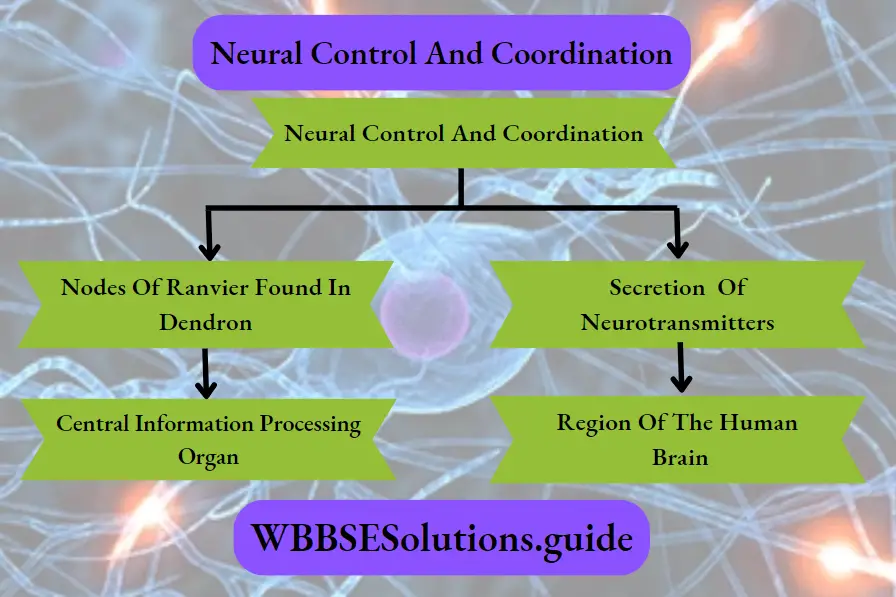Biology Class 11 WBCHSE Neural Control And Coordination Questions And Answers
Question 1. What are the nodes of Ranvier? Are they found in Dendron also?
Answer:
The Myelin sheath of medullated nerve fibers is found on axons at intervals. Such periodic gaps of the myelin sheath are called nodes of Ranvier. Nodes of Ranvier help in the saltatory conduction of impulses.
The dendron of neurons is always hon-medullated, so the dendron lacks a node of Ranvier.

Question 2. Mention the location and process of secretion of neurotransmitters in the synaptic cleft.
Answer:
Neurotransmitters (e.g., ACh) are present in the synaptic vesicles within the axolemma of the synaptic knob of axon in the presynaptic neuron.
Synaptic vesicles fuse with the presynaptic membrane and by exocytosis they are released in the synaptic cleft.
” class 11 neural control and coordination”
Question 3. Which organ is considered a ‘central information processing organ’? Where is it located?
Answer:
The human brain is considered the ‘central information processing organ’.
It is located within a special cavity called the cranium or brain box in the human skull.
Read and Learn More WBCHSE Solutions For Class 11 Biology
Question 4. Which is the largest and most important region of the human brain? What are the names of its two symmetrical parts?
Answer:
The largest and most important region of the human brain is the cerebrum.
The two symmetrical parts of the cerebrum right and left cerebral hemispheres.
Biology Class 11 WBCHSE
Question 5. What is the corpus callosum? Is it found in the brains of other species?
Answer:
The transverse, bundle of nerve fibers, that holds the two cerebral hemispheres together is known as the corpus callosum.
| Class 11 Biology | Class 11 Chemistry |
| Class 11 Chemistry | Class 11 Physics |
| Class 11 Biology MCQs | Class 11 Physics MCQs |
| Class 11 Biology | Class 11 Physics Notes |
” class 11 biology chapter 21 ncert solutions “
Yes, not only humans, but all vertebrates (except platypus) have corpus callosum in their brains.
Question 6. What are grey matter and white matter? Why they are named such?
Answer:
The central nervous system consists of two types of tissues—grey matter and white matter.
The grey matter is mainly composed of neuronal cell bodies, unmyelinated axons, glial cells, synapses, and capillaries. Due to the absence of a myelin sheath, this tissue appears grey. Hence, this name was given.
The white matter is composed of myelinated axons, hence, they appear white and are named such

Question 7. What is known as the cerebral medulla? What is its composition?
Answer:
The region interior to the cerebral cortex, in each cerebral hemisphere of the human cerebrum, is known as the cerebral medulla.
” class 11 neural control and coordination”
The cerebral medulla is composed of white matter. This region contains numerous medullated nerve fibers. Note that due to the presence of myelin sheath in the medullated nerve fibers, this region appears white.
Question 8. What is a cerebral aqueduct? orWhat is corpora quadrigemina?
Answer:
The third and fourth ventricles of the human brain are connected by a duct of the midbrain. This duct is known as the cerebral aqueduct or aqueduct of Sylvius.
On the tectum of the human midbrain, four spherical swellings or lobes are observed. Together, these are known as corpora quadrigemina.
Biology Class 11 WBCHSE
Question 9. Which part of the human brain is known as the brain stem? or Which part of the human brain is involved in breathing and secretion of saliva?
Answer:
The part of the brain that remains connected to the spinal cord is known as the brain stem. The human brain stem is composed of the midbrain (mesencephalon), pons varolii (included in metencephalon), and medulla oblongata (myelencephalon).
The medulla oblongata of the hindbrain controls breathing and secretion of saliva.
” class 11 biology chapter 21 notes”
Question 10. What is a yellow spot or macula lutea? What is fovea? Mention one use of fovea.
Answer:
The convex region at the middle of the retina is known as the yellow spot or macula lutea.
The central part of the yellow spot is more depressed. This part is known as fovea centralis or fovea in short.
The fovea is the most photoreceptive area of the retina. Image is formed on this region when an object is minutely tracked and observed.
Question 11. Where is Organ of Corti located? or Where is stereocilia present? or What is known as the tectorial membrane?
Answer:
The organ of Corti is located in the basilar membrane of the membranous labyrinth in the human inner ear.
neural control
The organ of Corti contains hair cells. Their terminal ends are connected to nerve fibers and their free ends contain numerous cilia. These cilia are called stereocilia.
The elastic membrane present above the hair cells of the organ of Corti is known as the tectorial membrane.
Biology Class 11 WBCHSE
Question 12. What is known as crista ampullaris? or What is its function?
Answer:
The sensory spots present in the ampullae of the semicircular canals are called crista ampullaris.
Crista ampullar is the sense organ of rotation.
